Click on images to enlarge

infestation growing along a fence-line (Photo: Land Protection, QDNRW)
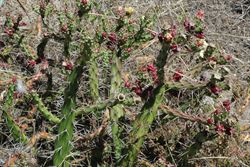
habit (Photo: Rob and Fiona Richardson)
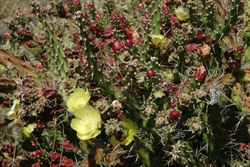
habit (Photo: Rob and Fiona Richardson)
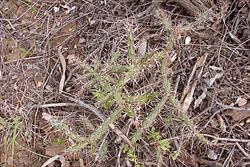
habit (Photo: Sheldon Navie)
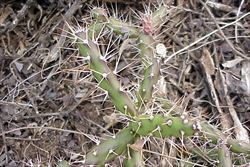
spiny stem segments (Photo: Sheldon Navie)
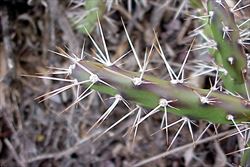
almost cylindrical stem segment with spines (Photo: Sheldon Navie)
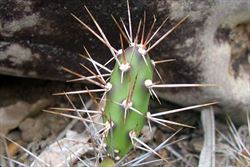
close-up of spines (Photo: Sheldon Navie)
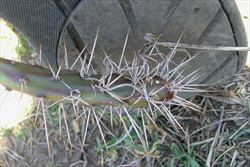
stem segment attached to shoe (Photo: Sheldon Navie)
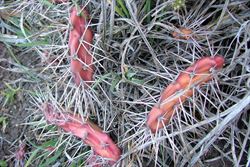
detached stem segments (Photo: Sheldon Navie)
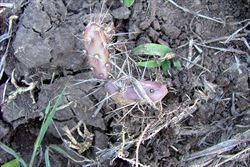
a detached stem segment that has developed roots (Photo: Sheldon Navie)
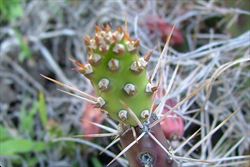
young stem segment with tiny leaves (Photo: Sheldon Navie)
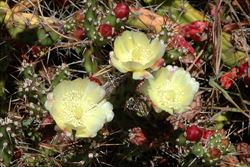
flowers (Photo: Rob and Fiona Richardson)
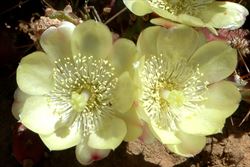
close-up of flowers (Photo: Rob and Fiona Richardson)
Scientific Name
Opuntia aurantiaca Lindl.
Synonyms
Opuntia x aurantiaca Lindl.Opuntia ferox Haw (misapplied)
Family
Cactaceae
Common Names
jointed cactus, jointed prickly pear, tiger pear, tiger-pear
Origin
Native to South America (i.e. northern Argentina, Paraguay and Uruguay).
Naturalised Distribution
A widespread species that is found throughout the eastern parts of Australia. It is most common in the sub-coastal regions of southern and central Queensland, and in central and eastern New South Wales. A few scattered infestations are also present in northern Victoria.
Also naturalised in southern Africa and probably beyond its native range in South America.
Habitat
Mostly found in semi-arid regions and drier localities in sub-tropical and warmer temperate environments. A weed of pastures, open woodlands, fence-lines, roadsides and stream-banks.
Habit
A low-growing (i.e. prostrate or decumbent), fleshy (i.e. succulent) plant forming thickets and producing underground tubers. It usually grows less than 40 cm tall when unsupported, but can reach up to 2 m in height when growing against other plants.
Distinguishing Features
- a spreading fleshy plant usually forming thickets less than 40 cm tall.
- its dark green to purplish-coloured stems consist of a series of almost cylindrical segments.
- these stem segments (3.5-30 cm long and 1-5 cm thick) are covered in groups of grey or brownish coloured barbed spines (1-5 cm long).
- its showy lemon or bright yellow flowers (25-60 mm across) have numerous 'petals'.
- its fleshy and spiny fruit (20-30 mm long) turn red with purplish mottling as they mature.
Stems and Leaves
Stems are dark green to purplish in colour, much-branched, and consist of a series of rounded, almost cylindrical (i.e. terete), segments. These stem segments (3.5-30 cm long and 1-5 cm thick) are covered in small raised bumps (i.e. areoles) that each bear 2-7 greyish or brownish coloured spines (1-5 cm long). The spines are very sharp, rigid, and minutely barbed near their tips.
The leaves are reduced to small cone-shaped (i.e. conical) structures (3-4 mm long) and are shed when the stems are still young (i.e. they are caducous).
Flowers and Fruit
The showy lemon or bright yellow flowers (25-60 mm across) are borne singly on a fleshy base. They have large numbers of 'petals' (most of these are actually petal-like structures known as petaloids) and numerous stamens. Flowering occurs mostly during late spring and summer.
The immature fruit are green in colour, but turn red to purplish as they mature. These fruit (20-35 mm long) are fleshy (i.e. succulent), spiny, and egg-shaped (i.e. ovoid) to somewhat pear-shaped (i.e. pyriform). They do not contain any viable seed.
Reproduction and Dispersal
This species reproduces by stem fragments (i.e. the stem segments easily become dislodged and produce roots) and underground tubers (these are formed when segments become buried and lose their spines).
Stem fragments are spread by becoming attached to animals, footwear and vehicles. They are also dispersed by flood waters and in dumped garden waste.
Environmental Impact
Tiger pear (Opuntia aurantiaca) is regarded as an environmental weed in Victoria, New South Wales and Queensland. This species was recently also listed as priority environmental weed in two Natural Resource Management regions.
Legislation
This species is declared under legislation in the following states and territories:
- New South Wales: Class 4 - a locally controlled weed. The growth and spread of this species must be controlled according to the measures specified in a management plan published by the local control authority and the plant may not be sold, propagated or knowingly distributed (throughout the entire state). This declaration also applies to all prickly pears (i.e. Opuntia spp.), except Indian fig (i.e. Opuntia ficus-indica).
- Northern Territory: B - growth and spread of this species to be controlled (south of 18°S latitude, in areas outside of towns), and C - not to be introduced into the Territory. This declaration also applies to all prickly pears (i.e. Opuntia spp.).
- Queensland: Class 2 - landowners must take all reasonable steps to keep land free of this species (throughout the entire state). It is also illegal to sell a declared plant or its seed in this state. This declaration also applies to all prickly pears (i.e. Opuntia spp.), except Indian fig (i.e. Opuntia ficus-indica).
- South Australia: 1@ - this species is declared under Class 1c, a classification for prohibited terrestrial plants. It is declared, and its control is required, throughout the entire state. This declaration also applies to all prickly pears (i.e. Opuntia spp.), except Indian fig (i.e. Opuntia ficus-indica).
- Western Australia: P1 - the movement of this species or its seeds is prohibited (for all local authority areas in that part of the state north of the 26th parallel of latitude), P2 - to be eradicated (for all local authority areas in that part of the state north of the 26th parallel of latitude, except for the Exmouth, Carnarvon, Murchison, Upper Gascoyne and Shark Bay local authority areas), and P4 - it must be 'contained' (in the Exmouth, Carnarvon, Murchison, Upper Gascoyne and Shark Bay local authority areas). This declaration also applies to all prickly pears (i.e. Opuntia spp.).
Management
For information on the management of this species see the following resources:
- the Biosecurity Queensland Fact Sheet on prickly pear identification and control, which is available online at http://www.dpi.qld.gov.au.
- the Northern Territory Department of Natural Resources, Environment and The Arts Agnote on this species, which is available online at http://www.nt.gov.au/weeds.
Similar Species
Tiger pear (Opuntia aurantiaca) is very similar to Harrisia cactus (Harrisia martinii ). It is also relatively similar to rope pear (Opuntia imbricata), boxing glove cactus (Opuntia fulgida var. mamillata), snake cactus (Opuntia spinosior) and jumping cholla (Opuntia prolifera). These species can be distinguished by the following differences:
- tiger pear (Opuntia aurantiaca) it a low-growing plant (usually less than 40 cm tall) with relatively small rounded (i.e. terete) or slightly flattened stem segments that do not have any ridges or humps. These stem segments have groups of 1-7 spines on most of the small raised bumps (i.e. areoles) on their surfaces. Its flowers are yellow or pale yellow in colour and its mature fruit are reddish or purplish.
- Harrisia cactus (Harrisia martinii) is a low-growing plant (usually less than 1 m tall) with very long almost cylindrical (i.e. terete) stem segments that have numerous pyramid-shaped (i.e. pyramidal) humps. These stem segments have groups of spines (1 or 2 large spines and several much smaller ones) on most of the smal raised bumps (i.e. areoles) on their surfaces. Its flowers are white or pinkish in colour and its mature fruit are bright red.
- rope pear (Opuntia imbricata) is a short shrub (usually 1-2 m tall) with almost cylindrical (i.e. terete) stem segments that have numerous raised humps (2-5 cm long) and are rope-like in appearance. These stem segments have groups of 3-15 spines on most of the small raised bumps (i.e. areoles) on their surfaces. Its flowers are reddish-purple in colour and its mature fruit are yellow.
- boxing glove cactus (Opuntia fulgida var. mamillata) is a short shrub (usually 1-2 m tall) with distorted stem segments that have numerous raised humps and are broader towards the tips. These stem segments have groups of 0-18 spines on most of the small raised bumps (i.e. areoles) on their surfaces. It usually does not produce flowers or fruit.
- snake cactus (Opuntia spinosior) is a short shrub (0.5-2 m tall) with almost cylindrical (i.e. terete) stem segments that have numerous raised humps (0.5-1.5 cm long) and are rope-like in appearance. These stem segments have groups of 4-24 spines on most of the small raised bumps (i.e. areoles) on their surfaces. Its flowers are red to reddish-purple in colour and its mature fruit are yellow.
- jumping cholla (Opuntia prolifera) is a short shrub (0.5-2.5 m tall) with almost cylindrical (i.e. terete) stem segments that have numerous raised humps (1.5-2.5 cm long) and are rope-like in appearance. These stem segments have groups of 6-12 spines on most of the small raised bumps (i.e. areoles) on their surfaces. Its flowers are reddish-purple to pinkish-purple in colour and its mature fruit are greenish in colour.

